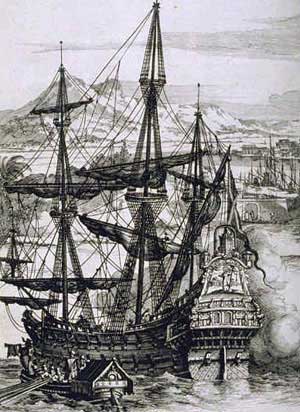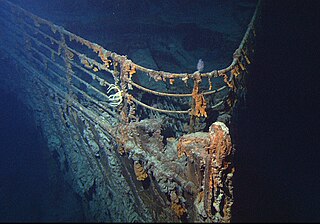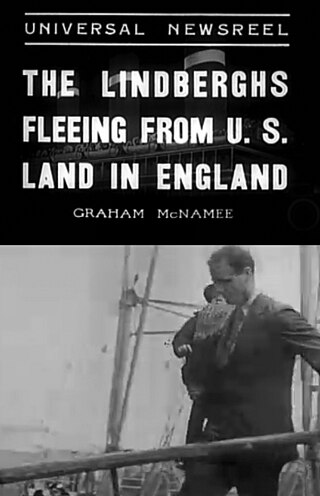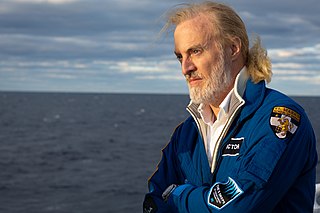
Robert Duane Ballard is an American retired Navy officer and a professor of oceanography at the University of Rhode Island who is most noted for his work in underwater archaeology: maritime archaeology and archaeology of shipwrecks. He is best known for the discoveries of the wrecks of the RMS Titanic in 1985, the battleship Bismarck in 1989, and the aircraft carrier USS Yorktown in 1998. He discovered the wreck of John F. Kennedy's PT-109 in 2002 and visited Biuku Gasa and Eroni Kumana, who saved its crew.

A submersible is an underwater vehicle which needs to be transported and supported by a larger watercraft or platform. This distinguishes submersibles from submarines, which are self-supporting and capable of prolonged independent operation at sea.

Edwin Albert Link was an American inventor, entrepreneur and pioneer in aviation, underwater archaeology, and submersibles. He invented the flight simulator, which was called the "Blue Box" or "Link Trainer". It was commercialized in 1929, starting a now multibillion-dollar industry. In total, he obtained more than 27 patents for aeronautics, navigation and oceanographic equipment.

Aliens of the Deep is a 2005 American documentary film directed in part by James Cameron alongside fellow cameraman and friend Steven Quale, and filmed in the IMAX 3D format. It was produced by Walden Media and Walt Disney Pictures. Cameron teams with NASA scientists to explore the mid-ocean ridges, submerged chains of mountains in the Atlantic and Pacific oceans that are home to some of the planet's more unusual forms of life.

Mir was a class of two self-propelled deep-submergence vehicles. The project was initially developed by the USSR Academy of Sciences along with Lazurit Central Design Bureau, and two vehicles were ordered from Finland. The Mir-1 and Mir-2, delivered in 1987, were designed and built by the Finnish company Rauma-Repola's Oceanics subsidiary. The project was carried out under the supervision of constructors and engineers of the Shirshov Institute of Oceanology.

An aquanaut is any person who remains underwater, breathing at the ambient pressure for long enough for the concentration of the inert components of the breathing gas dissolved in the body tissues to reach equilibrium, in a state known as saturation. Usually this is done in an underwater habitat on the seafloor for a period equal to or greater than 24 continuous hours without returning to the surface. The term is often restricted to scientists and academics, though there were a group of military aquanauts during the SEALAB program. Commercial divers in similar circumstances are referred to as saturation divers. An aquanaut is distinct from a submariner, in that a submariner is confined to a moving underwater vehicle such as a submarine that holds the water pressure out. Aquanaut derives from the Latin word aqua ("water") plus the Greek nautes ("sailor"), by analogy to the similar construction "astronaut".

The R/V Akademik Mstislav Keldysh is a 6,240 ton Russian scientific research vessel. It has made over 50 voyages, and is best known as the support vessel of the Mir submersibles. The vessel is owned by the Shirshov Institute of Oceanology of the Russian Academy of Sciences in Moscow, and is homeported in Kaliningrad on the Baltic Sea. Named after the Soviet mathematician Mstislav Keldysh, it usually has 90 people on board. Among its facilities are 17 laboratories and a library.
John Chatterton is an American wreck diver. Together with Richie Kohler, he was one of the co-hosts for the History Channel’s Deep Sea Detectives, for 57 episodes of the series. He is also a consultant to the film and television industries and has worked with 20th Century Fox, Paramount Pictures, and CBS.
Emory Kristof was an American photographer. He was on the expedition that discovered the Titanic. His work has been published in National Geographic Magazine and elsewhere.
Michael C. Barnette is an accomplished diver, author, photographer and founder of the Association of Underwater Explorers.

Robert Pierre André Sténuit is a Belgian journalist, writer, and underwater archeologist. In 1962 he spent 24 hours on the floor of the Mediterranean Sea in the submersible "Link Cylinder" developed by Edwin Link, thus becoming the world's first aquanaut.

René Théophile "Phil" Nuytten was a Canadian entrepreneur, deep-ocean explorer, scientist, inventor of the Newtsuit, and founder of Nuytco Research Ltd.

Breadalbane was an 1843 British three-masted merchant barque that was crushed by ice and sank in the Arctic in 1853. Notable as one of the northernmost shipwrecks known, she is also considered one of the best-preserved wooden ships ever found in the sea due to slow deterioration in the cold Arctic water. Historically, Breadalbane is considered to be a time capsule.

The wreck of the Titanic lies at a depth of about 12,500 feet, about 370 nautical miles south-southeast off the coast of Newfoundland. It lies in two main pieces about 2,000 feet (600 m) apart. The bow is still recognisable with many preserved interiors, despite deterioration and damage sustained hitting the sea floor. In contrast, the stern is heavily damaged. A debris field around the wreck contains hundreds of thousands of items spilled from the ship as she sank. The bodies of the passengers and crew would also be distributed across the sea bed, but have since been consumed by other organisms.

Jon Morrow Lindbergh was an American underwater diver. He worked as a United States Navy demolition expert and as a commercial diver, and was one of the world's earliest aquanauts in the 1960s. He was also a pioneer in cave diving, and one of the children of aviators Charles Lindbergh and Anne Morrow Lindbergh.
Deep Diver was the name of a deep-sea scientific research submersible designed by Edwin Albert Link. Deep Diver was the first small submersible designed for lockout diving, allowing divers to leave and enter the craft while underwater. It was first launched in January 1966.

The following index is provided as an overview of and topical guide to underwater divers:

This is a list of underwater divers whose exploits have made them notable. Underwater divers are people who take part in underwater diving activities – Underwater diving is practiced as part of an occupation, or for recreation, where the practitioner submerges below the surface of the water or other liquid for a period which may range between seconds to order of a day at a time, either exposed to the ambient pressure or isolated by a pressure resistant suit, to interact with the underwater environment for pleasure, competitive sport, or as a means to reach a work site for profit or in the pursuit of knowledge, and may use no equipment at all, or a wide range of equipment which may include breathing apparatus, environmental protective clothing, aids to vision, communication, propulsion, maneuverability, buoyancy and safety equipment, and tools for the task at hand.

Victor Lance Vescovo is an American private equity investor, retired naval officer, sub-orbital spaceflight participant, and undersea explorer. He was a co-founder and managing partner of private equity company Insight Equity Holdings from 2000-2023. Vescovo achieved the Explorers Grand Slam by reaching the North and South Poles and climbing the Seven Summits, and he then visited the deepest points of all of Earth's five oceans during the Five Deeps Expedition of 2018–2019.













